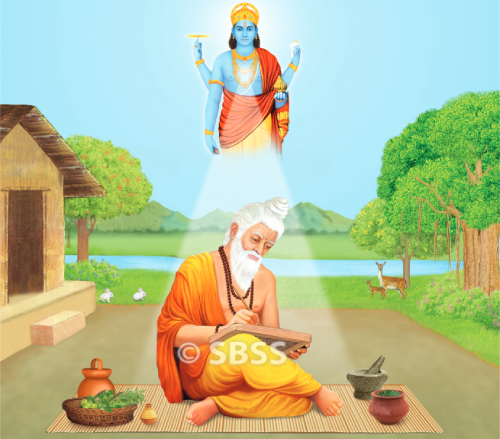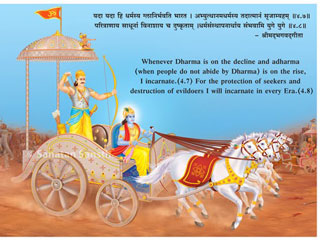Ayurveda for a healthy life ! – 20/2024

Roganam Karanani (Aetiological Factors of diseases)
Any consequence is not possible without a cause. Our ancient teachers have studied the causes of diseases in minute detail. Sushrutacharya is of the opinion that eliminating the cause of a disease is, in a way, treatment itself. While treating a disease if its cause is not eliminated, then it is likely to recur. Therefore, let us now understand the causes of diseases.
It is the aetiological factors which increase, decrease or vitiate the various doshas, dhatus and mala, which in turn gives rise to various diseases.
Classification of aetiological factors – They can be classified in various ways.
1. Sannikrushta and Viprakrushta
2. Pradhanika and Vyabhichari
3. Bahyahetu and Antarhetu
1. Sannikrushta and Viprakrushta
A. Sannikrushta
सन्निकृष्टो यथा नक्तंदिनर्तुभुक्तांशा दोषप्रकोपस्य हेतवः न ते चयादिकमपेक्षन्ते ।
Factors like day, night, season, diet, etc. which increase doshas immediately are known as sannikrushta causes example aggravation of asthma at night or during spring season or on exposure to dust. In short, they are the direct and immediate cause.
B. Viprakrushta : When the causative factor acts indirectly after a long period, it is known as viprakrushta.
हेमन्ते निचितः श्लेष्मा वसन्ते कफरोगकृत् ।
Example : Kapha keeps on accumulating in winter and disease manifests in spring. In this case, winter acts as viprakrushta or indirect cause while spring acts as a sannikrushta cause. In short, these are remote causes.
2. Pradhanika and vyabhichari
A. Pradhanika : The most important causative factor is known as pradhana or pradhanika cause
प्राधानिको यथा विषादिः । – मा. नि. १ (टीका)
Example : in poisoning, poison acts as a pradhanika cause.
B. Vyabhichari : The causative factor is so mild that by itself it never gives rise to manifest disease. The subclinical forms of the diseases are caused by vyabhichari factors.
3. Bahyahetu and Antarhetu
Bahyahetu that is external causes. Environmental factors like diet, activity etc. can give rise to disease, if it causes increase or decrease of dhatus (tissues), doshas or malas depending on whether their qualities are similar or opposite to the dhatus, doshas or malas. Waste products that is malas accumulate by suppression of natural urges, obstruction to their passage and decrease or increased quantity of products.
Aetiological factors giving rise to various diseases are as follows –
1. Beeja-bhagavayava-dushti – chromosomal and genetic factors
2. Doshaprakruti – constitutional factors
3. Doshavruddhikaranani – causes of increased doshas
4. Janmabalapravrutta-vikruti – congenital anomalies
5. Pradnyaparadha – not following the dictates of one’s own conscience
6. Kalakruta – environmental factors that is time and season
7. Vaya – age
8. Lingabheda – sex
9. Deshakruta – regional factors
10. Vyavasayika – occupational factors
11. Indriyanam Heena-Mithya-Atiyoga – excessive, inadequate or abnormal use of sense and motor organs
12. Vegavarodha – suppression of natural urges
13. Srotodushtl – vitiation of body channels
14. Agni – digestive power and tissue enzymes
15. Koshtha – motility of intestines
16. Ahara – diet
17. Aama – toxins
18. Manasika – psychological factors
19. Krumi roga – infectious and parasitic diseases
20. Janapadodhwansa – natural calamities and epidemics
21. Grahabadha – supernatural powers
22. Vaidyakruta – iatrogenic factors
23. Purvajanmakruta – idiopathic or unknown factors
1. Beeja-bhagavayava-dushti. i.e. Chromosomal and genetic factors
The word ‘Beeja’ means ‘seed’ that is fertilised ovum, ‘Beeja-bhaga’ means chromosome, which is derived from ‘bhaga’ meaning, part ‘beeja’ meaning fertilised ovum. The word ‘beeja bhagavayava’ means ‘gene’ which is avayava that is part of the beejabhaga that is chromosome.
Beeja-bhaga that is chromosomes constitute the parts of the ovum and sperm and are responsible for the hereditary characters. A defective chromosome or a part of chromosome that is gene is responsible for abnormalities of sex organs & defect in a particular organ. Members of certain families are inherently predisposed to develop diabetes mellitus, recurrent attacks of common colds, asthma etc.
Health as well as disease are primarily determined by quality of the genes. A person with all the genes of good quality leads a healthy and vigorous life of hundred years, provided he gets good food, pure air, clean water and follows the dictates of his conscience.
Genes play an important role in the causation of all natural diseases. Even in cases of infectious diseases which are caused
by germs, genes determine the resistance of the tissues or organs to the infective agent example individuals born with weak respiratory tract are susceptible to frequent attacks of cold, cough or asthma. Hence some persons hardly ever suffer from cold, while others develop cold, even on exposure to fan or after headbath.
2. Doshaprakruti that is Constitutional factors
Physical and psychological constitutions are partly genetic or hereditary and partly acquired being modified by intra-uterine and extra-uterine environmental factors as well as the diet and activities of the individual.
Amongst all constitutions, samaprakruti that is well balanced constitution is the healthiest one. Strictly speaking persons with Vata, Pitta and Kapha constitution are apparently healthy. Majority of people belong to the category of diseased constitution.
These individual constitutions are predisposed to disease by various environmental, seasonal, dietary factors & activities example a person with vata constitution living in jangala that is arid region, consuming diet increasing vata dosha like chana, vatana, wal etc. and engaged in over-exertion, fasting etc. is likely to develop vataja disease. On the other hand, a person with Vata constitution who stays in warm and humid climate, eats diet dominant in milk, ghee, oil, meat and takes adequate rest and sleep during the day is likely to remain free from vataja diseases.
A person with kapha constitution is likely to develop cough, breathlessness etc. and a person with pitta constitution is likely to suffer from peptic ulcer, high fever, bleeding disorders etc. Thus people with vata, pitta and kapha constitution get off the balance easily when they are exposed to environmental and dietary factors and activities increasing that particular dosha and present with various clinical manifestations depending on the dosha affected. On the other hand, person with sama constitution can tolerate environmental and dietary changes and activities easily and subdue the vitiated doshas if any.
Health is not mere absence of any disease, but the sense of well being and joy which is usually found with those having sama constitution. Hence the aim of all individuals should be to attain balanced constitution and maintain it. As a simple and effective measure Vata, Pitta, and Kapha constitution should take til oil, ghee and honey respectively.

 Take Disciplinary Action Against Charitable Hospitals Violating Rules : Surajya Abhiyan
Take Disciplinary Action Against Charitable Hospitals Violating Rules : Surajya Abhiyan Detergent found in ice-creams, phosphoric acid in soft drinks !
Detergent found in ice-creams, phosphoric acid in soft drinks ! Radiant Thoughts of Sachchidananda Parabrahman (Dr) Jayant Athavale
Radiant Thoughts of Sachchidananda Parabrahman (Dr) Jayant Athavale Law banning Conversion of Religion is against Individual Freedom : Babbles Former Judge S Muralidhar
Law banning Conversion of Religion is against Individual Freedom : Babbles Former Judge S Muralidhar Editorial : Khalistan, Balochistan and Pakistan
Editorial : Khalistan, Balochistan and Pakistan After India becomes a ‘Hindu Rashtra’, Russia will embrace Hinduism and spread it globally : Nostradamus’ Prophecy
After India becomes a ‘Hindu Rashtra’, Russia will embrace Hinduism and spread it globally : Nostradamus’ Prophecy